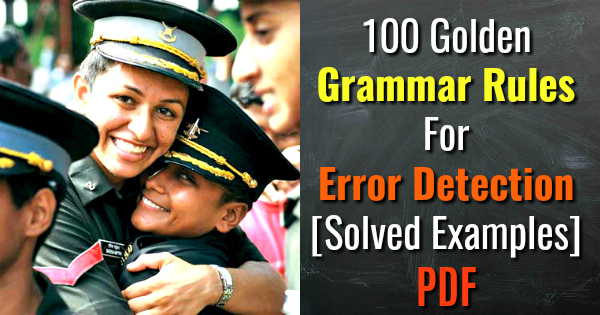If you are going to attempt the next CDS, AFCAT, NDA or TA exam then these 100+ rules of Spotting the Error & Sentence Correction will help you to make correct choices. These simple rules of error detection not only help in competitive exams but also in day to day use of English language.
Words, phrases, and sentences are the bases of any language. An error in their use may shake the very foundation of the language and make an expression meaningless or ambiguous in a context. Therefore, a defence aspirant has to clear those barriers before they begin their voluminous studies; and so sentence correction is one of the verbal problems in defence entrance examinations. Knowing the common structures and the nuances of the language is crucial to understand the written text and to express accurately and precisely.
The PDF book attached at the end of this article comprises of complete knowledge of all aspects related to Error detection and sentence correction. The file includes the basic English Grammar rules like Tense, adverbs, and adjective. The pdf book also has exercises categorized into three levels, i.e. Easy Level, Moderate Level and Hard Level keeping in view various defence exam pattern.
Current Affairs questions will be from last 5-7 months (for AFCAT, NDA, CDS, TA)
- Current Affairs Jan 2017 eBook [300+ Questions Included]
- Current Affairs Feb 2017 eBook [600+ Questions Included]
- Current Affairs March 2017 eBook [800+ Questions Included]
- Current Affairs April 2017 eBook [750+ Questions Included]
- Current Affairs May 2017 eBook [900+ Questions Included]
- Current Affairs June 2017 eBook [1100+ Questions Included]
100 Golden Grammar Rules For Error Detection
A. SUBJECT – VERB AGREEMENT
1 . Two or more Singular Subjects connected by and usually take a Verb in
the Plural.
For example,
Incorrect- Hari and Ram is here.
Correct- Hari and Ram are here.
2. If two Singular Nouns refer to the same person or thing, the Verb must be
Singular.
Incorrect- The Secretary and Principal are coming.
Correct- The Secretary and Principal is coming.
(Here the same person is .Secretary as well as Principal)
B. USES OF PARTICIPLES AND INFINITIVES
1. Ask, advise, allow, command, force, forbid, invite, encourage, compel,
beg, order•, imagine, instruct, permit, persuade, tell, require, remind, teach,
etc. are followed by Object + To +V2
For example,
Incorrect- He advised to do it by me.
Correct- He advised me to do it. But if these are used in Passive Voice, then
they are followed by To +V,.
C. USES OF VERBS
1. When there are two Subjects in a sentence and they are not in the same
Number, then we must have to use separate Auxiliaries (is, are, am, was,
were, have, has) for both of them.
For example,
Incorrect- Three- killed and one were injured.
Correct- Three were killed and one was injured.
2. A single Verb should be made to serve two Subjects, only when the form
of Verb is same for both the subjects.
Incorrect- I am seventeen years old and my sister fourteen.
Correct- I am seventeen years old and my sister is fourteen.






